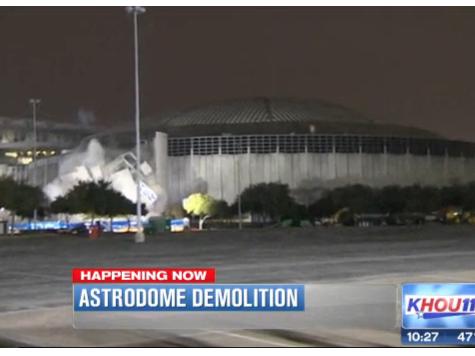
Late Sunday night, a construction company demolished three ramp towers of the Houston Astrodome. It was the first step in what is likely to be the complete demolition of the entire facility.
Known at the time as “The Eighth Wonder of the World,” the Astrodome opened in 1965 as the new home of the Houston Astros Major League Baseball team and the Houston Oilers of the NFL. The Oilers left after the 1996 season to become Nashville’s Tennessee Titans. After the 1999 season, the Astros moved into the newly constructed Minute Maid Park.
The Astrodome was the first domed stadium. It blazed the path for the modern sports stadium. No earlier sports stadium contained its previously unknown levels of opulence, both on and off the field. The Astrodome also set a new standard for the role of public financing in the construction of professional sports stadiums.
Prior to World War II, most professional sports teams played in privately owned stadiums. Yankee Stadium, for example, which could hold 60,000 fans and had twice the seating capacity of other Major League Baseball stadiums at the time, was built in 1923 with $2.5 million in private funding provided by New York Yankees owners Jacob Ruppert and Tillinghast Huston.
In 1931, Cleveland Municipal Stadium, built at a cost of $2.5 million (later increased to $3 million by over runs) and owned by the city of Cleveland, was one of the first professional sports stadiums paid for by taxpayers. For more than six decades it was home to Major League Baseball’s Cleveland Indians, and later, the NFL’s Cleveland Browns. Throughout its history, it was a financial drain on the taxpayers of Cleveland.
After World War II, several other professional sports franchises were able to convince local city and county governments to help finance the construction of new stadiums. The size of those financings, however, was significantly less than the Astrodome’s. Baltimore’s Memorial Stadium, home to Major League Baseball’s Baltimore Orioles and the NFL’s Baltimore Colts, was built in the early 1950s at a cost of $6.5 million.
At a total cost of $43 million, the Astrodome blew the lid off previous stadium construction costs. Of that initial cost, $37 million was paid for by a municipal bond guaranteed by the taxpayers of Harris County, and only $6 million was funded by private investors.
In November, just a month before the demolition of the three towers, voters of Harris County rejected a proposed $217 million bond offering that would have converted the Astrodome into a convention and exhibition center. Given that taxpayer rejection, the future of the facility remains unknown.
As the Houston Chronicle reported, the vote brought “the iconic but decaying stadium . . . a step closer to the wrecking ball.” Sunday’s demolition of the three ramp towers is likely to be followed relatively soon by the demolition of the entire facility.
Judge Roy Hofheinz was the man who conceived the idea of the Astrodome and organized the public and private groups that turned it into reality. The flamboyant Hofheinz got his start in 1930s, when he managed future President Lyndon Baines Johnson’s first political campaign. From 1936 to 1944 he served as the presiding judge (an elected executive position ) of Harris County. From 1953 to 1955 he was the mayor of Houston, an independent city within Harris County.
In the late 1950s, Hofheinz organized a group of investors, the Houston Sports Association, who secured the Major Leage Baseball expansion franchise for the Houston Colt 45s in October 1960. This major business success was accomplished one month before Hofheinz’s political mentor, Lyndon Johnson, was elected Vice President of the United States. The team began play in 1962 at Colt Stadium, and changed their name to the Astros when they moved into the Astrodome in 1965.
In the 1960s, Harris County sold $36 million in municipal bonds to finance most of the Astrodome. Harris County then leased the Astrodome for $750,000 annually for forty years to Hofheinz’s Houston Sports Association.
Image Source: KHOU TV

COMMENTS
Please let us know if you're having issues with commenting.